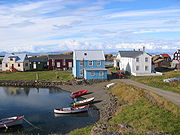
Flatey in Breiðafjörður
Encyclopedia

Breiðafjörður
Breiðafjörður is a large shallow bay, about 50 km wide and 125 km long and located in the west of Iceland. It separates the region of the Westfjords from the rest of the country. Breiðafjörður is encircled by mountains, including glacier Snæfellsjökull the Snæfellsnes peninsula on the south side...
on the northwestern part of Iceland
Iceland
Iceland , described as the Republic of Iceland, is a Nordic and European island country in the North Atlantic Ocean, on the Mid-Atlantic Ridge. Iceland also refers to the main island of the country, which contains almost all the population and almost all the land area. The country has a population...
. Flatey and its surrounding islands are, as a creation, believed to have forged from under the weight of a great glacier during the previous Ice age
Ice age
An ice age or, more precisely, glacial age, is a generic geological period of long-term reduction in the temperature of the Earth's surface and atmosphere, resulting in the presence or expansion of continental ice sheets, polar ice sheets and alpine glaciers...
. In terms of size, Flatey is some two kilometers long and about one kilometer wide, of which most is flat land (hence its name, meaning "flat island" in Icelandic
Icelandic language
Icelandic is a North Germanic language, the main language of Iceland. Its closest relative is Faroese.Icelandic is an Indo-European language belonging to the North Germanic or Nordic branch of the Germanic languages. Historically, it was the westernmost of the Indo-European languages prior to the...
), with scarcely any hills to be found.
The island has a seasonal habitation; most houses there are occupied only during summer. In winter, the island's total population is five people. In spite of this, Flatey used to be one of the main cultural centres of Iceland, with its no-longer existing monastery
Monastery
Monastery denotes the building, or complex of buildings, that houses a room reserved for prayer as well as the domestic quarters and workplace of monastics, whether monks or nuns, and whether living in community or alone .Monasteries may vary greatly in size – a small dwelling accommodating only...
(founded in 1172 ) standing on the highest point of the island as its beacon of knowledge. In the middle of the 19th century, Flatey was still a cultural and artistic centre yet with the added twist of it doubling as a hub of commerce for the northwest when appointed as such by the Danish crown in 1777.
From 1777 and on until around the latter part of the last century, Flatey enjoyed a healthy growth of its population and was for a long time, relative to size, massively populated.
Due to social change and changes of production and ensuing change of values and demands in the work place, its steady population has dwindled down to the minimum needed to support the community on a regular basis, a community which, during summer and holidays, multiplies in size due to a massive influx of second home owners, regular domestic visitors and foreign tourists.
The island has only the one single road, which leads from the ferry dock to the so-called "old village", which consists of some beautifully restored and painted old houses of the island's original inhabitants. There is, of course, also the old harbour, from where besides visitors and inhabitants travelling to and fro, the island's sheep are taken over to the mainland for slaughter
Animal slaughter
Slaughter is the term used to describe the killing and butchering of animals, usually for food. Commonly it refers to killing and butchering of domestic livestock ....
. Besides of sheep, most of Flatey's natural life consists of various kinds of mostly migratory birds, especially the puffin
Puffin
Puffins are any of three small species of auk in the bird genus Fratercula with a brightly coloured beak during the breeding season. These are pelagic seabirds that feed primarily by diving in the water. They breed in large colonies on coastal cliffs or offshore islands, nesting in crevices among...
.
Flatey also has a church, built in 1926. The church's interior is painted with scenes of the island life, made by a Catalan
Catalan people
The Catalans or Catalonians are the people from, or with origins in, Catalonia that form a historical nationality in Spain. The inhabitants of the adjacent portion of southern France are sometimes included in this definition...
painter, Baltasar Samper, in the 1960s in return for free accommodation when he was visiting the island. Now, the church bears the odd title of oldest and smallest library in Iceland, established in 1864. This library
Library
In a traditional sense, a library is a large collection of books, and can refer to the place in which the collection is housed. Today, the term can refer to any collection, including digital sources, resources, and services...
was once home to the Flatey Book
Flateyjarbók
The Flatey Book, is an important medieval Icelandic manuscript. It is also known as GkS 1005 fol. and by the Latin name Codex Flateyensis.- Description :...
, the largest of medieval Icelandic manuscripts.

